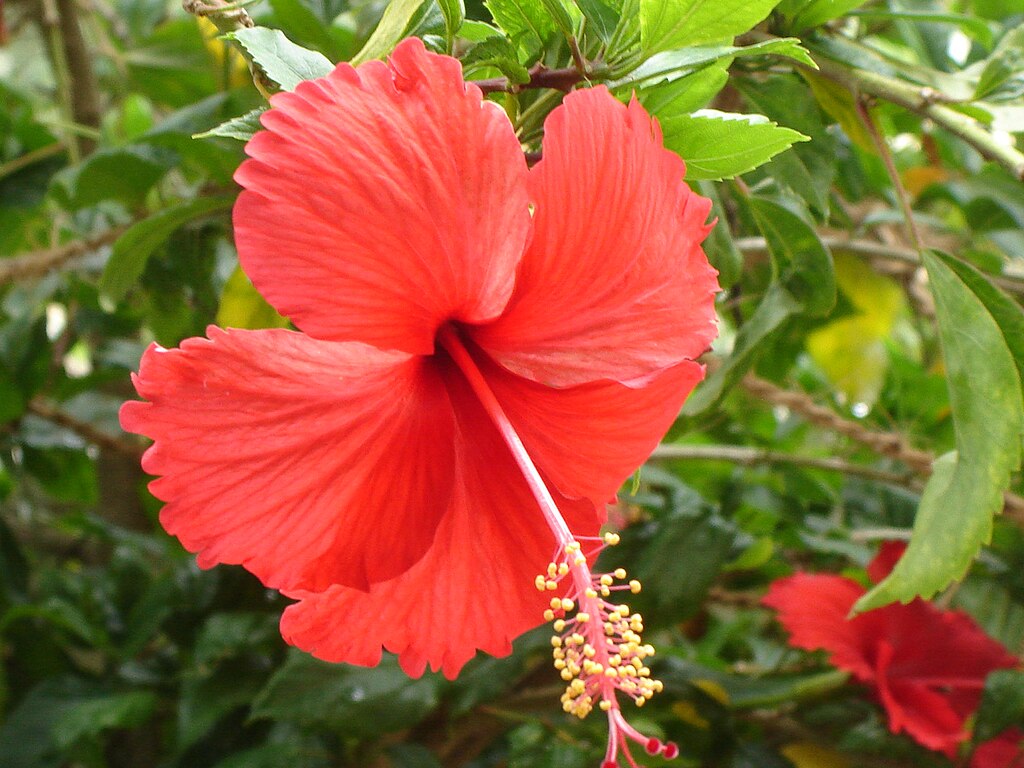Famous Flowers in Bali
In Bali, the symbolism linked to nature is very important. Plants and flowers are used for veneration of the gods, in temples, for the protection of a place or a person…. Most famous flowers in Bali: frangipani, heliconia, bird of paradise, magnolias, hibiscus, marigold, lotus, jasmine, bougainvillea and many more…
Some of the most famous flowers in Bali
Some of the most famous flowers in Bali include frangipani, heliconia, bird of paradise, magnolia, hibiscus, marigold, lotus, jasmine, and bougainvillea. These flowers not only add beauty to the island but also hold significant cultural and spiritual meaning.
Bali, also known as the “Island of the Gods,” is home to a diverse array of stunning flora, many of which are celebrated for their beauty and cultural significance. In Bali, the floral scents are very subtle and mix according to the plants and flowers that you see often in Bali; Magnolias, hibiscus, jasmine, bougainvillea, so many varieties of delicately scented flowers that perfume your nostrils.
The frangipani flower: an emblem of Bali
Bali has its own emblematic flower: that of the frangipani which is called here “Jepun” or “Kamboja” it projects a vision of mysticism, ancient traditions and rituals. The frangipani flower evokes the inner romance of the island, often described as magical Bali. A flower with an intoxicating smell greatly appreciated but also widely used by the Balinese in their daily lives.
The Balinese are very fond of flowers which are like an entity of nature that has a specific strength. In Hindu ceremonies in Bali the frangipani flower is always used.

Red Frangipani. Nick Hubbard, CC BY 2.0, via Wikimedia Commons
This flower has 2 important roles in our religion it is a symbol of the god Shiva and is also a means to pray, it is part of the offering.
The frangipani flower is used to indicate the purity of the heart when praying Sang Hyang Widi Wasa and its sacred light but also the ancestors. In addition to the frangipani flowers other flowers are used in our prayers, their color are as follows:
– white petals to the east of the offering are for the god Iswara
– red petals south of the offering are for the fierce Brahma
– yellow petals to the west of the offering are mostly frangipani flowers and are for the god Mahadeva
– blue or green petals to the north of the offering are for Vishnu.

Plumeria (Frangipani). Bernard Spragg. NZ from Christchurch, New Zealand, CC0, via Wikimedia Commons
We very often find frangipani trees next to temples or houses because in this way we can use frangipani flowers at any time to pray or put them in offerings.
According to Hindu philosophy the frangipani flower when it is the fourth full moon which is a good month. This tree is considered “Sari Alam”: something that can bring enlightenment and goodness.
The symbol of the lotus in Balinese culture
This beautiful flower that is the lotus for you can only represent beauty but for us Balinese it has several meanings that we will explain to you, one of which is very important…
In Sangskrit the word for lotus is Padma. So if one day in Bali you read the name of a street: Jalan Padma (there is one in Legian) you will know that it means Lotus Street.
Saraswati and lotus
Very often the Hindu, Buddhist, Chinese goddesses are represented seated on a lotus (The Hindu goddess of knowledge for example: Saraswati). Moreover, if you visit the Saraswati temple in Ubud you will be in awe of the beauty of the place thanks to all the lotuses there, it is no coincidence given the link between Saraswati and the lotus. Lakshmi, goddess of luck and prosperity is the wife of Vishnu.
She is also often represented seated on a lotus, her traditional symbol. But in fact visually almost all Hindu gods and goddesses are represented with a lotus which serves as their seat to highlight their purity and divine status. But more than anything the lotus is the symbol of beauty, prosperity and fertility. According to Hinduism in every human there is the sacred spirit of the lotus. It also represents eternity, purity and divinity as you will have understood.
Danghyang Dwijendra: “lotus flower” of the Earth
The lotus has a close relationship with Balinese culture. Balinese scripture Danghyang Dwijendra indicates Bali as Danghyang Dwijendra: “lotus flower” of the Earth. The lotus flower is the “king” of all flowers and is mentioned in many stories. Balinese temples contain many structures and the most important is the Padmasana or lotus throne. The Padmasana is a large stone-hewn tower, with an empty stone seat or lotus throne which is reserved for Sanghyang Widi Wasa (the supreme God).

Lotus flowers. Jon Sullivan, Public domain, via Wikimedia Commons
The Padmasana is located so that it faces away from the sacred mountain: Mount Agung. In South Bali the Padmasana is located in the northeast corner of the temple while in North Bali it is located in the southeast corner of the temple. The throne in general is 2 meters (6.5 ft) high and is thus above the heads of the faithful. In much larger versions of Padmasana there are even steps leading up to the throne so that people can place offerings there. The entire structure symbolizes the entire cosmos from the underworld to heaven. Around the base there are representations such as mountains to indicate the physical world of man.
In general here is what the colors of the lotus mean:
– the white and pink lotus: purity and devotion.
– red/purple/blue lotus: have a spiritual meaning in the sense of ascension or recognition.
– a green lotus flower is a great gift for someone trying to improve their life and start good habits.
The lotus is above all symbolic for the ancient and modern world who celebrate beauty in art and in religion which have a strong cultural connection with Bali. So what are you waiting for to plant your own lotus?
Bird of Paradise Symbols
Strelitzia, bird of paradise, or crane lily.
The meanings of the bird of paradise symbolize the notion of freedom, magnificence, and luck. The bird of paradise flower is a symbol of freedom, like a free bird in the air. This beautiful flower reminds us to let go of our worries and embark on a new adventure.
The meanings of the bird of paradise flower are multiple:
- Freedom – The bird of paradise flower is a symbol of freedom, like a free bird in the air. This beautiful flower reminds us to let go of our worries and embark on a new adventure.
- Success and Excellence – This flower makes a great gift for someone who has just been promoted or graduated from college or someone you want to see succeed.
- Optimism and Joy – It is also a symbol of optimism and positive energy, especially because of its bright, bold colors and interesting shapes. This beautiful flower reminds us to always be cheerful and keep a smiling face no matter how hard life may be.
- Loyalty – The Bird of Paradise flower is both a symbol of the ninth wedding anniversary and a great way to tell your partner that you are faithful and totally committed to them.
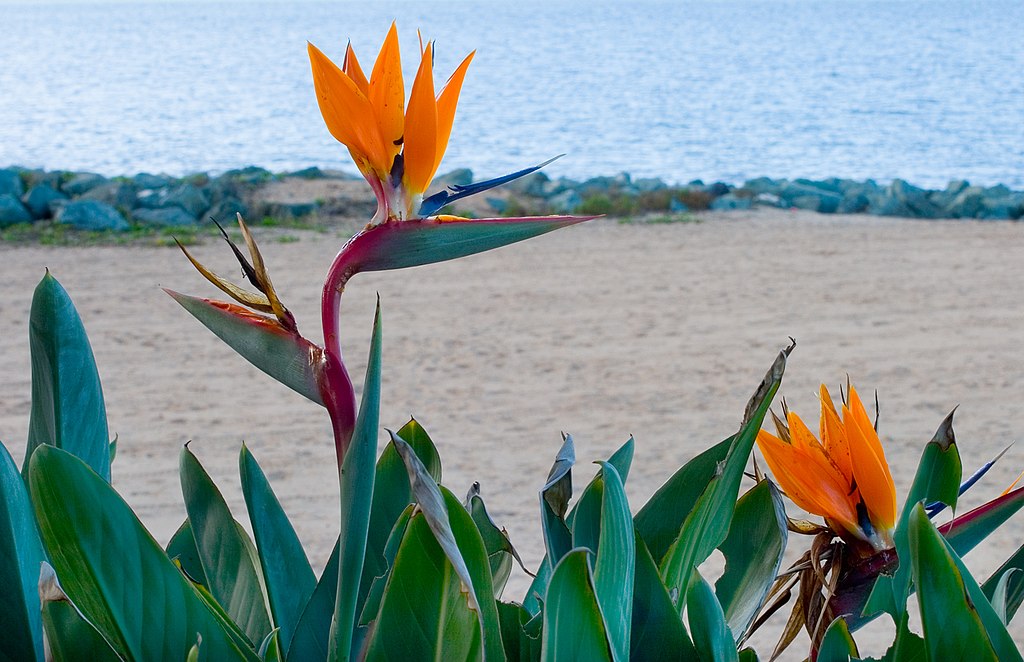
Bird of paradise. Sheba_Also 43,000 photos, CC BY-SA 2.0, via Wikimedia Commons
Hibiscus is a sacred flower
The hibiscus, dedicated to Ganesha, Shiva and the goddess Kali. White flowers express purity, refinement, elegance and perfection.
The offering of its flowers is effective when one makes the “archana”, that is to say when one offers the flowers while reciting the mantras or the sacred formulas. They are supposed to make the mantras effective and to obtain the siddhis, occult powers. Hibiscus flower decoctions help purify the blood and the heart. They improve the quality of skin and hair. They are effective in problems of excessive bleeding during menstruation, it is said.
Hibiscus flower decoctions help purify the blood and the heart. They improve the quality of skin and hair. They are used to treat excessive bleeding problems during menstruation.
Red Hibiscus. Aravindan Shanmugasundaram, CC BY 3.0, via Wikimedia Commons
Read also: Useful Tips for Visiting Temples in Bali
Jasmine flowers
Jasmine flowers are, as we have seen, offered during pujas or Hindu ceremonies, because of their white color and their fragrance. These are called sattwika flowers. They increase pure love and compassion.
Jasmine flowers are said to influence the psyche of humans and make the mind receptive; they help to receive and radiate the vibrations of the mantras. They combine well with sandalwood paste in most cases. It is the floral symbol of ideal love!
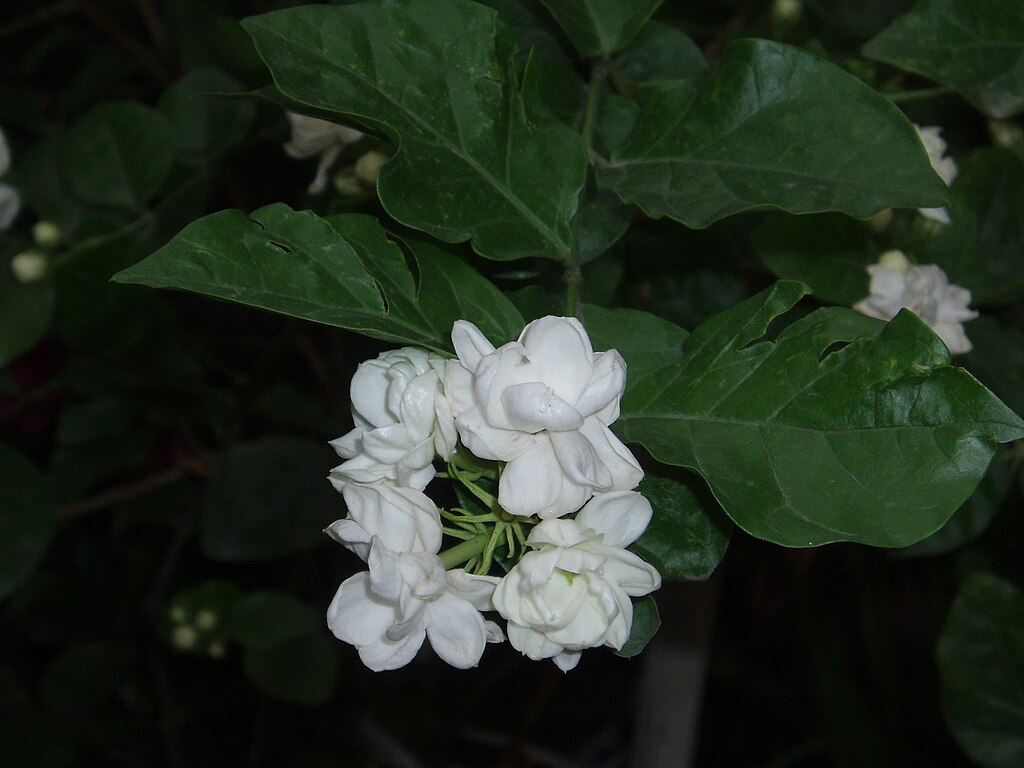
Jasmin Sambac or Melati Putih in Indonesian language. Taken by Fanghong, CC BY-SA 3.0, via Wikimedia Commons
Bougainvillea, named after the famous navigator
These shrubs with sumptuous colored bracts were brought back to Europe in the 18th century by the famous navigator Louis-Antoine de Bougainville. This is a symbol of passion, welcome and peace.
There are several species but it is mainly hybrids of Bougainvillea spectabilis and Bougainvillea glabra that are grown.
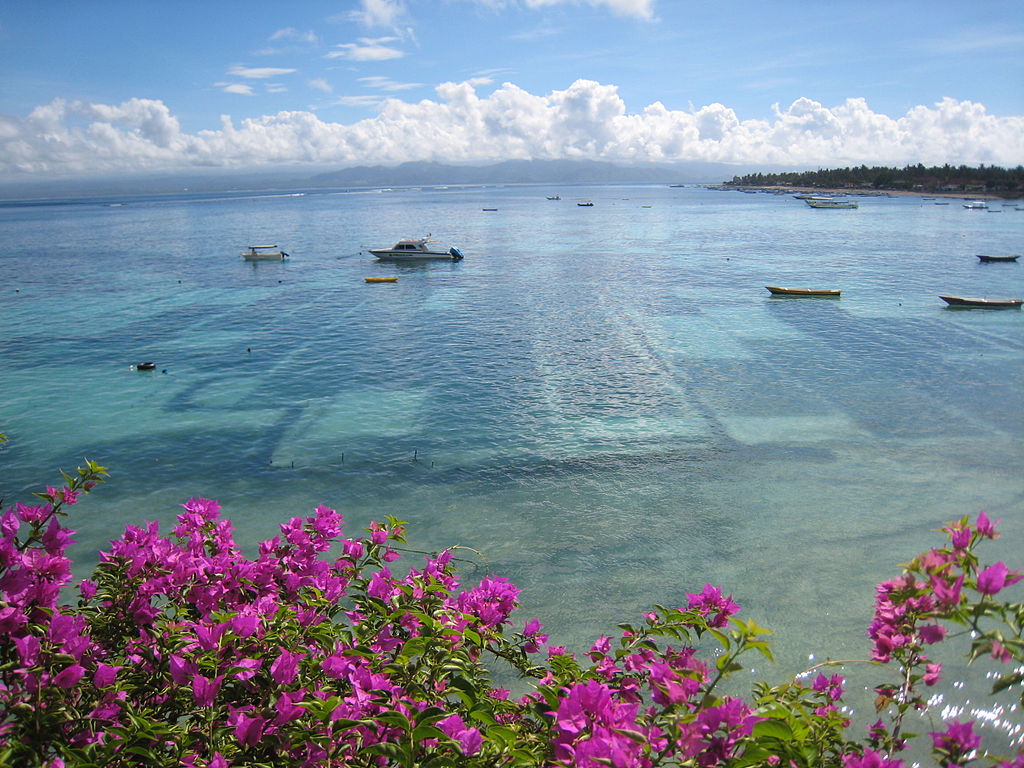
Bougainvillea in Nusa Lembongan. Shura from Amsterdam, Netherlands, CC BY 2.0, via Wikimedia Commons
Marigold
Marigolds were discovered by the Spaniards in Mexico and it was the Portuguese who brought them to India and then to Indonesia.
Marigolds are considered a religious symbol for Hindus who use them as offerings to gods and goddesses in the form of a simple flower or garland.
Before entering a temple, stalls allow you to choose flowers or garlands to make an offering. In the homes of Brahmins, Marigolds are used every day in the family temple for the performance of puja, the ritual ceremony to the gods.

Marigold. Pashminu Mansukhani, CC0, via Wikimedia Commons
Heliconia
One of the most famous flowers in Bali is Heliconia. It is native to Central and South America as well as a few South Pacific islands and was not first described until 1786. This attractive plant is now cultivated in all tropical regions of the world. However, there are 200 varieties, so he is not that alone!
The plant takes its name from the Greek mountain Helikon, on which the Muses stood. The inhabitants of this mountain always remained fresh, beautiful and young. Mount Helicon is in Boeotia, central Greece. So, if you always want to stay young and beautiful, it is essential to buy a Heliconia. And why not several, to be sure of the result.
![]()
Heliconia rostrata Filo gèn’, CC BY-SA 4.0, via Wikimedia Commons
Anthurium
Anthuriums send a message of hospitality. It is one of the prettiest exotic flowers, it is native to Colombia and Ecuador, and is characterized by its pink color and a distinctive peak of yellow starting from the center of the flower, but also by its large reddish leaves. . If you want to find exotic flowers that will make a splash for your wedding ceremony, you will not go wrong by choosing anthuriums and your guests will remember them!

Red Anthurium. Ezhuttukari, CC BY-SA 3.0, via Wikimedia Commons
Lollipop (golden shrimp plant, pachystachys lutea)
Lollipop flower in Indonesian language is bunga lilin (candle flower). It is native to the tropical regions of America (Brazil, Peru, Ecuador, Colombia and Central America). It is grown elsewhere as an ornamental plant.
The meaning of this flower is an integration of knowledge and spirituality. It helps with navigating between brain knowledge and spiritual truth. It is often planted in gardens and homes to bring good fortune to the owners.
In addition to its cultural significance, the lollipop plant is also used in traditional Balinese traditional medicine. The leaves of the plant are used to make a tea that is used to treat a variety of conditions, including fever, headache, and stomach upset.
Pachystachys lutea. Dryas, CC BY-SA 3.0, via Wikimedia Commons
Magnolia champaca (Cempaka)
The Magnolia champaca, known as “Cempaka” in Bali, holds cultural significance and is often associated with various meanings in Balinese traditions.
Used in religious ceremonies, it symbolizes purity and is pleasing to the gods. Its sweet scent represents divinity and creates a spiritually uplifting atmosphere.
Its presence is believed to promote a sense of harmony and balance in both spiritual and physical realms, extending blessings and good wishes to others.
Additionally, it can signify love and beauty, and is used in funerals to guide souls. Offering Cempaka shows respect and is believed to bring harmony and blessings. Overall, the Cempaka’s importance in Bali’s cultural and religious traditions is profound.
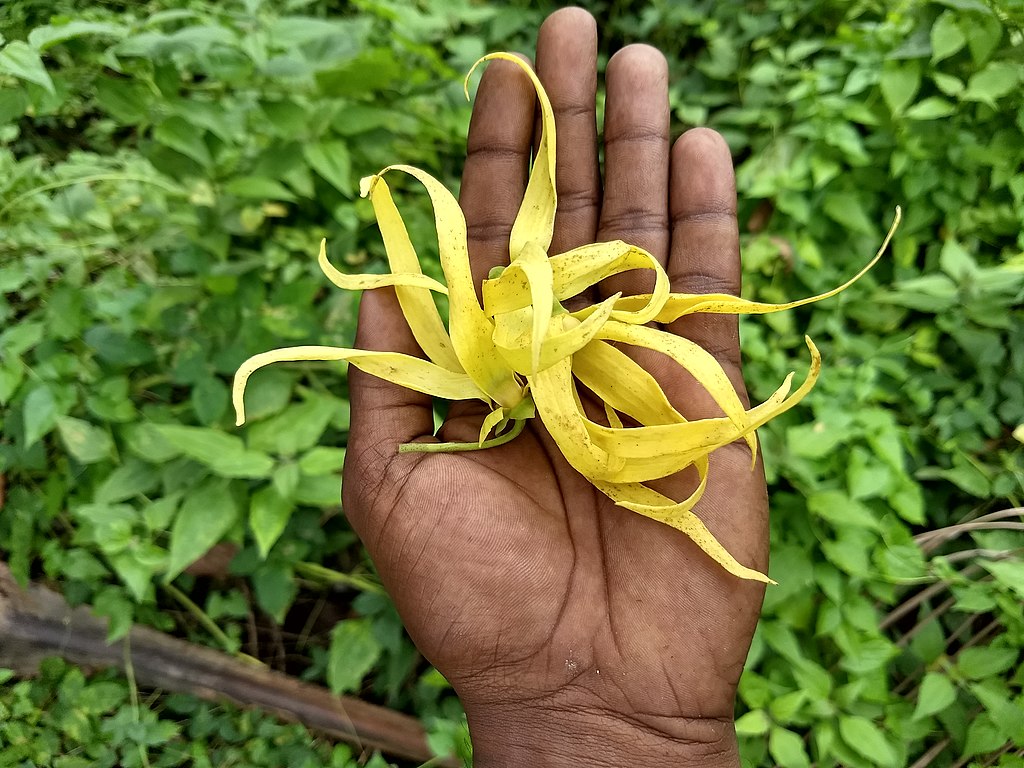
Magnolia champaca (Bunga cempaka). Renjusplace, CC BY-SA 4.0, via Wikimedia Commons
Allamanda (Golden trumpet)
Allamanda flowers are popular tropical plants known for their vibrant and trumpet-shaped blooms. The Allamanda flower is native to tropical and subtropical regions of the Americas, primarily found in Central and South America. In Bali, Allamanda flowers can be found adorning gardens, parks, and landscapes, adding a burst of color to the lush surroundings. These flowers come in various shades, including bright yellow, golden, and even peach-colored varieties.
This is a significant flower in Balinese culture because it is associated with prosperity, good luck, and spirituality.
The Allamanda plant is well-suited to Bali’s warm and tropical climate. Its large, glossy leaves provide an attractive backdrop to the striking flowers. Many Balinese gardens feature Allamanda as ornamental plants, creating beautiful displays of natural beauty.

Allamanda cathartica. Ngocnk2, CC BY-SA 3.0, via Wikimedia Commons
Beyond their aesthetic appeal, Allamanda flowers also hold cultural significance in Bali, where flowers play an important role in traditional ceremonies and offerings. They are often used in religious ceremonies, temple offerings, and as decorations during special events.
So, if you visit Bali, you’re likely to encounter the cheerful and vibrant Allamanda flowers gracing the landscape, contributing to the island’s natural beauty and cultural richness.
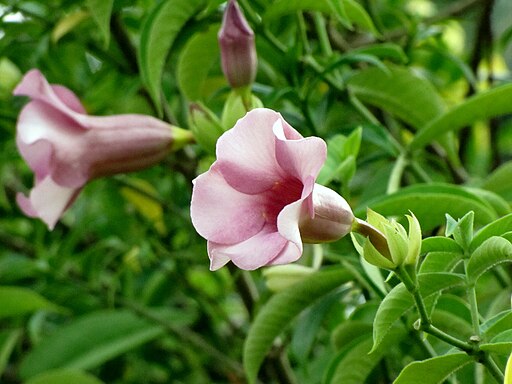
Allamanda blanchetii. Vaikoovery, CC BY 3.0, via Wikimedia Commons
White buttercup (Turnera subulata or Bali Buttercup)
Turnera subulata, also known as white buttercup, is a flowering plant in the passionflower family. It is native to Central and South America, but has been introduced to many other parts of the world, including Bali.
The white buttercup is also a symbol of purity and enlightenment in Balinese culture. It is believed that the flower can help people to achieve a higher level of consciousness. The flower is also used in traditional Balinese medicine to treat a variety of conditions, including respiratory problems and skin conditions.

Turnera subulata. Abutorsam007, Public domain, via Wikimedia Commons
Senduduk (Melastoma malabathricum)
This is a native plant of Bali that is commonly found in forests and along riverbanks. It is a small shrub that grows to a height of about 1-2 meters. The plant has bright green leaves and produces clusters of small, purple flowers.
Senduduk is also a symbol of purity and innocence in Balinese culture. It is believed that the flower can help people to cleanse their souls and to achieve a higher level of consciousness. The flower is also used in traditional Balinese medicine to treat a variety of conditions, including skin diseases and respiratory problems.

Melastoma malabathricum. Vengolis, CC BY-SA 3.0, via Wikimedia Commons
It’s important to note that the specific meanings and uses of famous flowers in Bali may vary based on individual beliefs, local customs, and cultural interpretations. The list provided includes flowers that are commonly found and culturally significant in Bali. While some of them may not be exclusive to Bali, they are indeed native or well-established in the region. The white buttercup is a significant flower in Balinese culture. It is used in religious offerings, traditional medicine, art, and literature. The flower is also a popular tourist attraction.
Sources: CleverlySmart, Facts of Indonesia, Medium
Photo credit (main picture): Author: Renesis (CC BY-SA 3.0) via Wikimedia Commons
Escape to Villa Carissa and discover a world of tranquility, and unforgettable experiences
Escape to Villa Carissa, your stepping place to experience tranquility, luxury, and unforgettable moments in the heart of Bali. Book your private pool villa now for a perfect blend of relaxation and exploration.
Whether you’re traveling with family, friends, or on a romantic getaway, villa Carissa in Seminyak center offers the perfect base for exploring Bali’s many attractions and enjoying a relaxing vacation.


